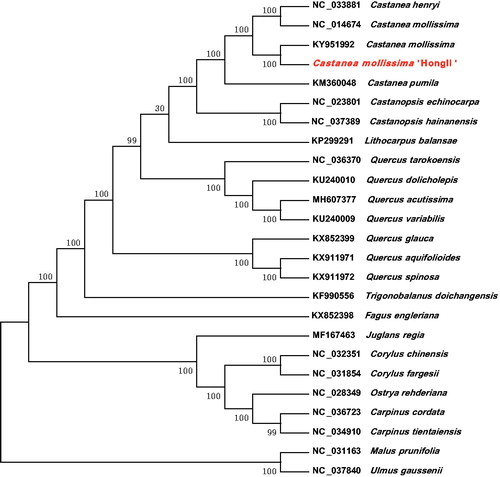Abstract
Chinese Chestnut (Castanea mollissima) is an economically valuable tree in China. More than 300 wild and cultivated varieties were reported. In this study, we reported and characterized the complete chloroplast genome sequence of Chinese Chestnut cultivar ‘Hongli’, variant dominant strain with high yield, good quality of nuts, especially with red coloration in their leaves, twigs, and involucres of fruits. The chloroplast genome was determined to be 160,871 bp in length. It contained large single-copy (LSC) and small single-copy (SSC) regions of 90,498 and 18,971 bp, respectively, which were separated by a pair of 25,701 bp inverted repeat (IR) regions. The genome is predicted to contain 130 genes, including 83 protein-coding genes, 37 tRNA genes, 8 rRNA genes, and 2 pseudo genes. The overall GC content of the genome is 36.7%. A phylogenetic tree reconstructed by 25 chloroplast genomes reveals that C. mollissima 'Hongli' is most closely related to wild C. mollissima that was collected from China.
Chinese chestnut (Castanea mollissima Blume) is native to China and acts as an important commercial nut tree. Chestnut species have been cultivated for three millennia. More than 300 wild and cultivated varieties have been reported in China. It is likely that the ecological environment and artificial selection had affected the genome of orchard-grown chestnuts (Labonte et al. Citation2018). Although the chloroplast (cp) genome of wild Chinese chestnut has been reported, little is known about the chloroplast genome of cultivated Chinese chestnut (Cheng et al. Citation2018). Here, we characterized the complete chloroplast genome sequence of C. mollissima 'Hongli', which has enhanced red coloration in their leaves, twigs, and involucres of fruits, based on the genome skimming sequencing data. This genome data can provide intragenic information for clarifying the taxonomic identities and valuable information about the evolution of Castanea.
The total genomic DNA was extracted from the fresh leaves of C. mollissima 'Hongli' (The Chestnut Germplasm Resource Nursery in Nanjing Botanical Garden Mem. Sun Yat-Sen, N32°03′20.79″, E118°49′53.37″) using the DNeasy Plant Mini Kit (Qiagen, Valencia, CA, USA). The DNA was stored at −80 °C in our lab. The whole genome sequencing was conducted by Nanjing Genepioneer Biotechnologies Inc. (Nanjing, China) on the Illumina Hiseq platform. The filtered sequences were assembled using the program SPAdes assembler 3.10.0 (Bankevich et al. Citation2012). Annotation was performed using the DOGMA (Wyman et al. Citation2004) and BLAST (McGinnis et al., Citation2004) searches. The plastome of C. mollissima 'Hongli' was determined to comprise a double-stranded, circular DNA of 160,871 bp (NCBI acc. no. MK352487) and it contained two inverted repeats (IR) regions of 25,701 bp each, separated by large single-copy (LSC) and small single copy (SSC) regions of 90,498 and 18,971 bp, respectively. The genome was predicted to contain 130 genes, including 83 protein-coding genes, 37 tRNA genes, 8 rRNA genes, and 2 pseudogenes. Six protein-coding genes, seven tRNA genes, and four rRNA genes were duplicated in the IR regions. Nineteen genes contained one intron and two genes (clpP and ycf3) contained two introns. The overall GC content of C. mollissima 'Hongli' cp genome is 36.7% and the corresponding values in LSC, SSC, and IR regions are 34.6, 30.8, and 42.7%, respectively.
To investigate its taxonomic status, alignment was performed on the 25 chloroplast genome sequences using MAFFT v7.307 (Katoh and Standley Citation2013) and a maximum likelihood (ML) tree (Malus prunifolia and Ulmus gaussenii were used as the outgroup) was constructed by FastTree version 2.1.10 (Price et al. Citation2010). As expected, C. mollissima 'Hongli' is mostly related to wild C. mollissima that was collected from China with bootstrap support values of 100% ().
Figure 1. Phylogenetic tree inferred by maximum likelihood (ML) method based on the complete chloroplast genome of 25 representative species. Malus prunifolia and Ulmus gaussenii were used as the outgroup. A total of 1000 bootstrap replicates were computed and the bootstrap support values are shown at the branches.

Disclosure statement
The authors report no declaration of interest.
Additional information
Funding
References
- Bankevich A, Nurk S, Antipov D, Gurevich AA, Dvorkin M, Kulikov AS, Lesin VM, Nikolenko SI, Pham S, Prjibelski AD, et al. 2012. SPAdes: a new genome assembly algorithm and its applications to single-cell sequencing. J Comput Biol. 19:455–477.
- Cheng L, Huang W, Lan Y, Cao Q, Su S, Zhou Z, Wang J, Liu J, Hu G. 2018. The complete chloroplast genome sequence of the wild Chinese chestnut (Castanea mollissima)[J]. Conserv Genet Resour. 10:291–294.
- Katoh K, Standley DM. 2013. MAFFT multiple sequence alignment software version 7: improvements in performance and usability[J]. Mol Biol Evol. 30:772–780.
- Labonte NR, Zhao P, Woeste K. 2018. Signatures of selection in the genomes of Chinese chestnut (Castanea mollissima Blume): the roots of nut tree domestication. Front Plant Sci. 9:810.
- McGinnis S, Madden TL. 2004. BLAST: at the core of a powerful and diverse set of sequence analysis tools. Nucleic Acids Res. 32:W20–W25.
- Price MN, Dehal PS, Arkin AP. 2010. FastTree 2–approximately maximum-likelihood trees for large alignments[J]. PloS One. 5:e9490.
- Wyman SK, Jansen RK, Boore JL. 2004. Automatic annotation of organellar genomes with DOGMA. [J]. Bioinformatics. 20:3252–3255.
